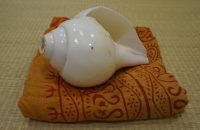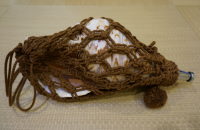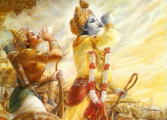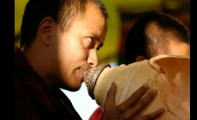Sound of conch shell trumpets (click the pictures to listen)
-

Shankha of Brahmanic and/or Hindu ascetics (about 6 inches long)

HORAGAI of Shugendo practitioners (about 17 inches long)
Passing through the path of civilization and culture in Eurasia continent spans from India to Tibet and China, "Shankha", conch shell trumpet for Brahmanic and Hindu rituals arrived at Japan--the terminal of the path that assimilate all things. The great essence of conch shell trumpet was taken and assimilated by ancient Japanese and consequently HORAGAI was developed. The sound involves a mystic undulation ("Hado" in Japanese) which may spread beyond dimensional space to resonate with individual vibration energy of substances as well as human bodies. HORAGAI is to purify objective of prayer as well as practitioners themselves.
Origin of Horagai
- Horagai is inseparable from Shugendo. Its origin is conch shells among
ritual articles used in ancient India and Tibetan Mahayana Buddhism. Even
in modern India, conch shell trumpet called "Shankha" is used
in Brahmanic and Hindu Homa rituals. It is said that Horagai may reproduce
sacred primordial sounds of "a-un" (A-UN) or "om" or
"aum" generated by the cosmic vibration that resulted in all
creation of the universe and the earth. This sound is also chanted in mantra
of Tantric Buddhism.


Buddhist teachings on Horagai
- "Hora-wo-fuku", literally meaning "blow conch shell", has a slangy meaning such as "boast" or "speak gibberish". However, Horagai involves sacred meanings in Buddhist teachings that brings out the manifestation of Dainichi Nyorai (or Mahavairocana). Transcending the three worlds of past, present, and future, his preaching leads all living beings to the state of awareness as dispelling the ignorance of the world by blowing conch shell loudly to rumble everywhere.
"To blow the conch-shell horn of the great Dharma, to beat the drum of the great Dharma, c.." an excerpt from The Lotus Sutra
"Beat the drum of warcc" an except form Kuonjyo Darani-Kyo

Purpose of playing Horagai
- In invocation, to play Horagai is to purify anything, to remove evil, and to kill tempters.
In homa or rituals, playing Horagai is expressing great delight in deepening faith. That is, "your belief deepens as you deepen your dedication to magnificence".
In ascetic training, playing Horagai is a ritual for manifestation of Dainichi Nyorai, for spiritual meditation, and for attaining Buddhahood with the present body.